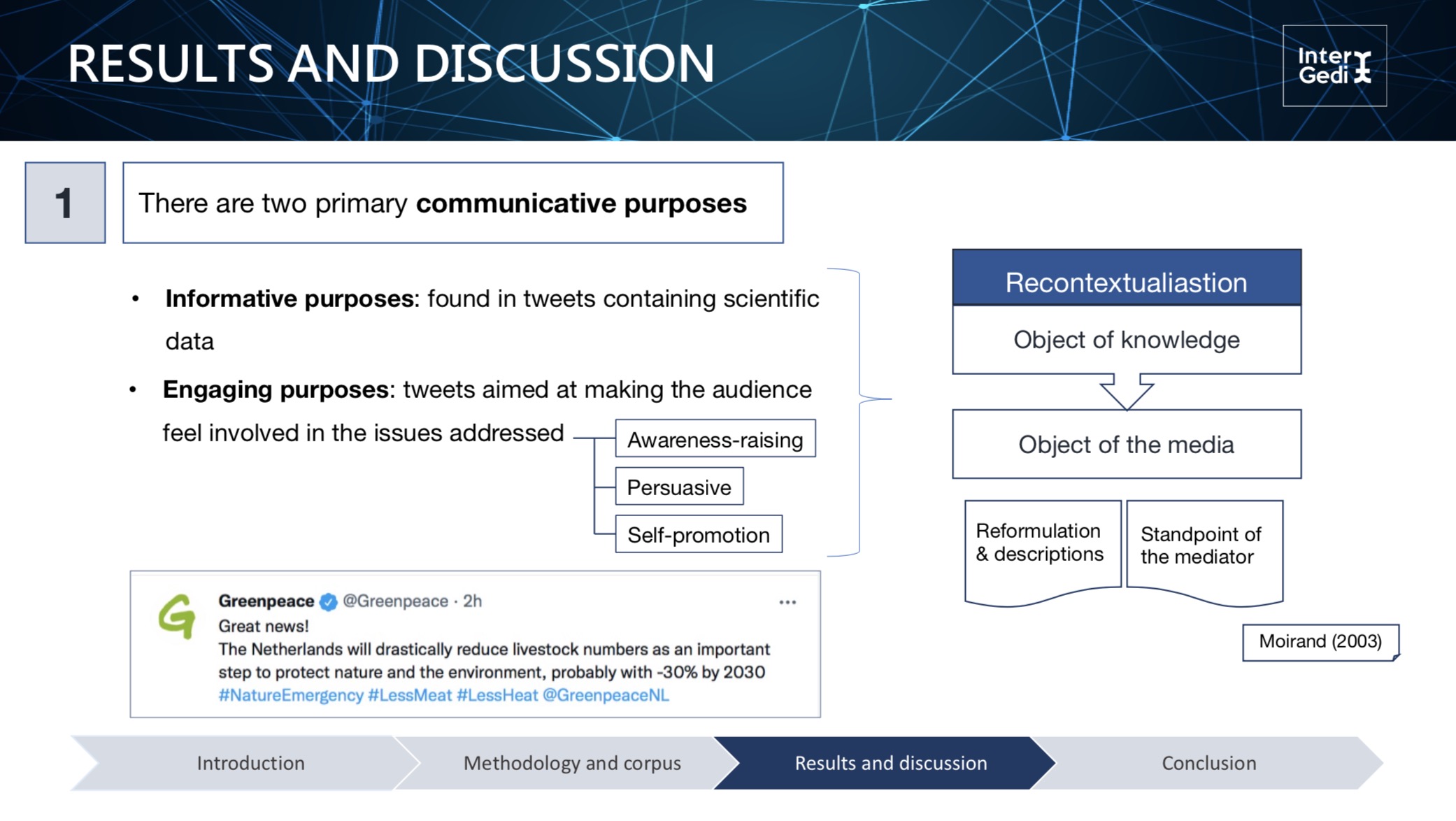CMC 2023: Ana Sancho analyses science dissemination practices on Twitter

Ana E. Sancho-Ortiz presented her paper “Scientific communication on social media: Analysing Twitter for knowledge recontextualisation” at the 10th International Conference on CMC and Social Media Corpora for the Humanities, which was organised by the University of Mannheim (Germany) and the Leibniz Institute for the German Language (IDS).
In this conference, which took place on 14th-15th September 2023, Sancho-Ortiz dealt with scientific dissemination practices carried out by organisational Twitter accounts on environmental purposes. She specifically focused on how the verbal and the visual mode, as well as diverse types of hyperlinks (e.g., hashtags, outbound links and tags) are conveniently combined in this type of text to reach informative and engagement purposes.
The full abstract of Ana E. Sancho-Ortiz’s talk can be consulted as follows:
Scientific communication on social media: Analysing Twitter for knowledge recontextualisation
In the last decades and as a result of the growing concern with ensuring the democratisation of science, Twitter has gained importance within the scientific community as a means for the transmission of specialised knowledge both within experts and non-expert audiences. Considering this, the present paper studies the phenomenon of science dissemination and popularisation on Twitter, taking the official accounts of Greenpeace and WWF as its object of analysis. For this purpose, a total of 100 tweets from these accounts were gathered and analysed through manual reading. Based on this analysis, it was found that Twitter for science dissemination primarily responds to informative and engagement purposes, which are materialised through the convergence of the verbal and visual modes and the combination of diverse types of hyperlinks (e.g., hashtags, tags and outbound links). As a result, it was concluded that the use of Twitter features and affordances for science dissemination is determined by the prevalence of non-expert audiences over expert ones.
References
Askehave, I. (1999). Communicative purpose as genre determinant. HERMES-Journal of Language and Communication in Business, (23), 13-23
Askehave, I., & Nielsen, A. E. (2005). Digital genres: a challenge to traditional genre theory. Information technology & people, 18(2), 120-141.
Bednarek, M., & Caple, H. (2017). The discourse of news values: How news organizations create newsworthiness. Oxford University Press.
Belcher, D. D. (2023). Digital genres: What they are, what they do, and why we need to better understand them. English for Specific Purposes, 70, 33-43.
Bezemer, J., & Kress, G. (2008). Writing in Multimodal Texts: A Social Semiotic Account of Designs for Learning. Written Communication, 25(2), 165–195.
Bondi, M., & Cacchiani, S. (2021). Knowledge communication and knowledge dissemination in a digital world. Journal of Pragmatics, 186, 117-123.
Brown, P., & Levinson, S. (1987). Politeness: Some Universals in Language Usage. Cambridge University Press.
Calsamiglia, H., & Van Dijk, T. A. (2004). Popularization discourse and knowledge about the genome. Discourse & society, 15(4), 369-389
Denton Jr, R. E. (1980). The rhetorical functions of slogans: Classifications and characteristics. Communication quarterly, 28(2), 10-18.
Insall, R. (2023). Science Twitter—navigating change in science communication. Nature reviews molecular cell biology, 24, 305-306.
Jayes, L. T., Fitzsimmons, G., Weal, M. J., Kaakinen, J. K., & Drieghe, D. (2022). The impact of hyperlinks, skim reading and perceived importance when reading on the Web. PloS ONE, 17(2): e0263669.
Kress, G. (2000). Multimodality. In B. Cope and M. Kalantzis (Eds.) Multiliteracies: Literacy Learning and the Design of Social Futures (pp. 182–202). Routledge.
Kress, G. (2010). Multimodality. A social semiotic approach to contemporary communication. Routledge.
Kress, G., & Van Leeuwen, T. (2006). Reading images: The grammar of visual design. Routledge.
Kurtulmuş, F. (2021). The democratization of science. In Ludwig, D., Koskinen, I., Mncube, Z., Poliseli, L. & Reyes-Galindo, L. (Eds.) Global epistemologies and philosophies of science (pp. 145-154). Routledge.
Luzón, M. J., & Pérez-Llantada, C. (2019). Science Communication on the Internet: old genres meet new genres (Vol. 308). John Benjamins Publishing Company.
Maireder, A., & Ausserhofer, J. (2014). Political discourses on Twitter: Networking topics, objects, and people. In Weller et al., (Eds.) Twitter and society (pp. 305-318). Peter Lang.
Moirand, S. (2003). Communicative and cognitive dimensions of discourse on science in the French mass media. Discourse studies, 5(2), 175-206.
Norris, S. (2004). Analyzing multimodal interaction: A methodological framework. Routledge.
Norris, S., & Maier, C. D. (2014). Interactions, images and texts: A reader in multimodality. Walter de Gruyter.
Siever, C. M., Siever, T., & Stöckl, H. (2020). Emoji-text relations on Instagram: Empirical corpus studies on multimodal uses of the iconographetic mode. In Stöckl, H., Caple, H., & Pflaeging, J. (Eds.) Shifts towards image-centricity in contemporary multimodal practices (pp. 177-203). Routledge.
Squires, L. (2016). Twitter: Design, discourse, and the implications of public text. In Georgakopoulou, A., & Spilioti, T. (Eds.) The Routledge handbook of language and digital communication (pp. 239-256). Routledge.
Swasy, J. L., & Munch, J. M. (1985). Examining the target of receiver elaborations: Rhetorical question effects on source processing and persuasion. Journal of consumer research, 11(4), 877-886.
Tang, Y., & Hew, K. F. (2017). Using Twitter for education: Beneficial or simply a waste of time?. Computers & education, 106, 97-118.
Yılmaz, F., Elmas, T., & Eröz, B. (2023). Twitter-based analysis of anti-refugee discourses in Türkiye. Discourse & Communication, 17(3), 298-318.Zappavigna, M. (2011). Ambient affiliation: A linguistic perspective on Twitter. New media & society, 13(5), 788-806.
